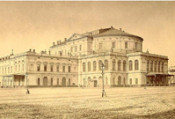
The Mariinsky Theatre was solemnly opened in St. Petersburg
The Mariinsky Theatre was solemnly opened on October 2 (14) 1860 in St. Petersburg on Theatre Square, instead of the Circus Theatre destroyed by fire.
In 1775-1783 on Circus Square (from 1810s — Theatre Square) according to plans by Antonio Rinaldi was built the first monumental building in Russia, specially erected for a theatre, which for a long time was considered to be the largest one in Europe. It was the Stone Theatre, established on the Decree of the Empress Catherine II in 1773. Up to middle 19th c. the Stone Theatre held concerts, balls and performances of the court troupe. In the end of the century, in 1896 the Stone Theatre building was almost completely reconstructed and extended by the architect V.V. Nicolas for the St. Petersburg conservatoire.
It was for a long time that the opposite side of Theatre Square was empty. During the reign of Nicholas I a great Theatre Circus (1847-1848) by the design of the architect A.K. Cavos was constructed opposite the Stone Theatre. The Circus Theatre was very popular among Petersburg public who enjoyed performances of acrobats, magicians and horsemen. Ten years after the opening, in 1859 the Circus Theatre was completely destroyed by fire except for stone walls, vaulted ceilings of corridors and staircases. In view of the fire, reconstruction of the Alexandrinsky and Mikhailovsky theatres on the order of the Emperor Alexander I was delayed, and in a year the building on Theatre Square was reconstructed under the direction of the architect Alberto Cavos.
On October 2 (14) 1860 took place a solemn inauguration of a new theatre called Mariinsky, which was named after Alexander II spouse — Empress Maria Alexandrovna. The first season in the new building opened with Mikhail Glinka’s “A Life for the Tsar”.
The architect created all the conveniences for eminent visitors: the Tsar’s box and the Imperial Court Minister’s box had separate front lobbies, foyers and staircases. The hall interior, which survived without any serious changes to our days, was richly decorated.
Twice did the interior of the Mariinsky Theatre undergo reconstructions: in 1884–1886 to the design of the Imperial Theatre’s architect Viktor Schröter the backstage space was reconstructed, in 1894–1896 under the direction of engineer Smirnov the spectators’ part was renovated.
A unique curtain of the Mariinsy Theatre, which as the matter-of-fact became its symbol, was created in 1914 based on the sketches of the famous theatre artist A. Golovin. In 1952 artists S. Virsaladze and M. Zandin changed the curtain’s color gamut — instead of dark red it became blue, matching the main color of the hall decoration.
Many world opera and ballet first nights, which later became recognized as classics and gems of theatres worldwide were staged at the Mariinsky Theatre: “Prince Igor” by Alexander Borodin, “Sleeping Beauty” and “The Queen of Spades” by Pyotr Tchaikovsky, “Raymonda” by Alexander Glazunov, “Romeo and Juliet” by Sergei Prokofiev. For a long time Marius Ivanovich Petipa was the first ballet master at the Mariinsky Theatre. Here performed Fyodor Komissarzhevsky, Fyodor Stravinsky, Fyodor Shalyapin, Osip Petrov, Anna Pavlova, Vaslav Nijinsky, Mathilda Kschessinskaya, Galina Ulanova, Rudolf Nureyev, Mikhail Baryshnikov and many others.
In 1920 the Mariinsky Theatre was renamed the State Academic Theatre of Opera and Ballet. In 1935 it was named after Sergei M. Kirov, and became commonly known as the Kirov Theatre. During the Great Patriotic War and Leningrad Siege the building of the Mariinsky Theatre was dramatically destroyed by air bombs and shelling, however by autumn 1944 it was completely reconstructed.
Between 1966-1970 the theatre underwent a major reconstruction as a result of which an extension was built in the southern side of the new building. This building was constructed in a common style with the theatre itself and housed a rehearsal room. The stage was also renovated: thanks to new technical means there appeared a possibility of using the orchestra pit in various ways, and making use of complicated decorative effects. In 1992 the theatre returned its historical name.
To date the second stage is being under construction near the historical building of the theatre.
Lit: О театре [Электронный ресурс] // Мариинский театр. 1998-2016. URL: https://www.mariinsky.ru/about/history/mariinsky_theatre/; Классический танец. История и современность. М., 1987; Мариинский оперный театр [Электронный ресурс] // Архитектурный сайт Санкт-Петербурга. 2007-2016. URL: http://www.citywalls.ru/house3884.html; Пантеон и репертуар русской сцены. СПб., 1850; Театр оперы и балета имени С. М. Кирова. Л., 1983.

